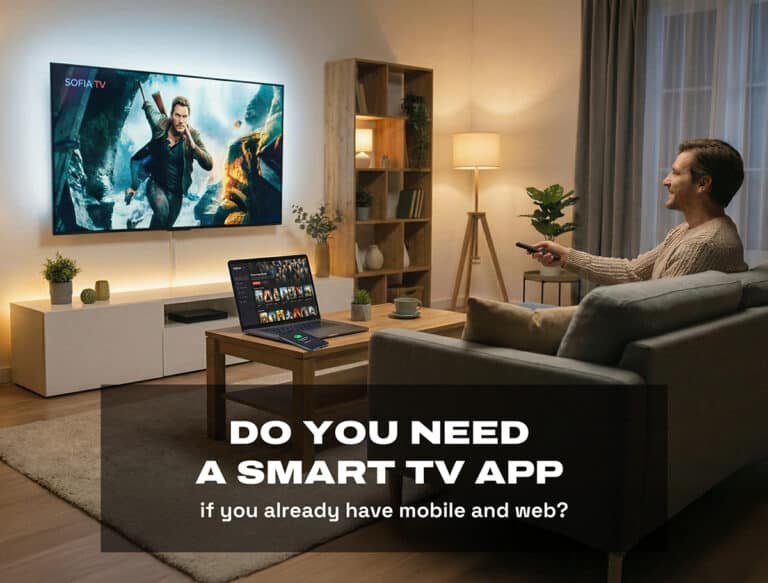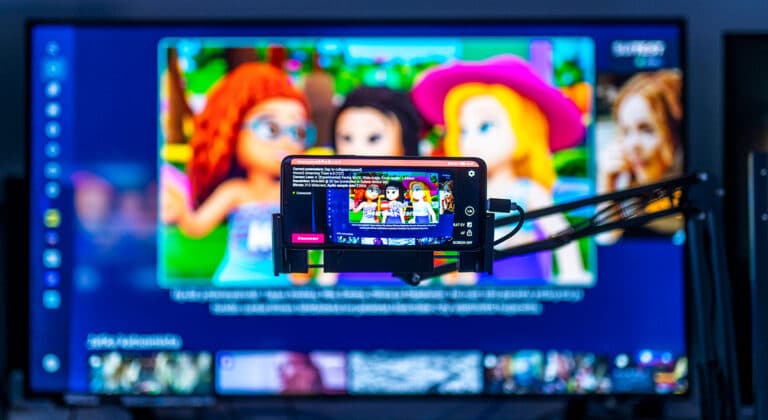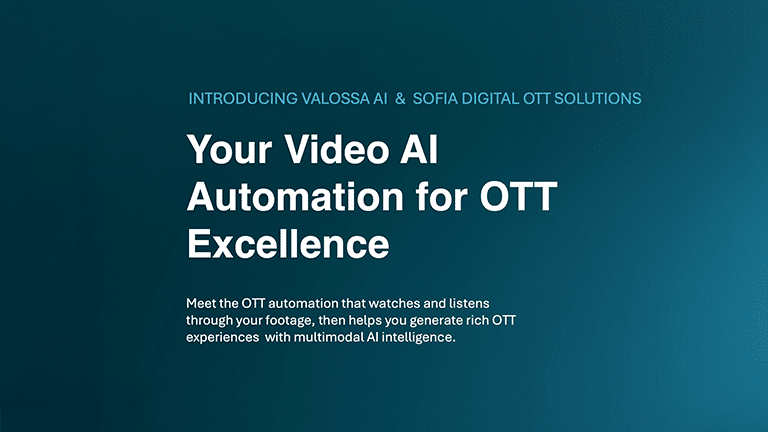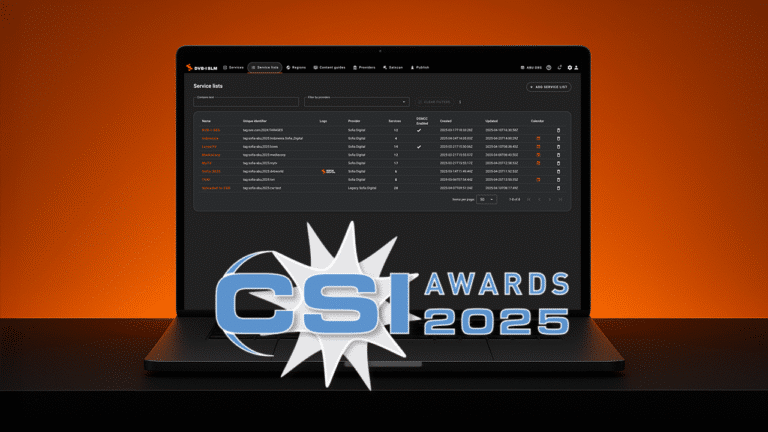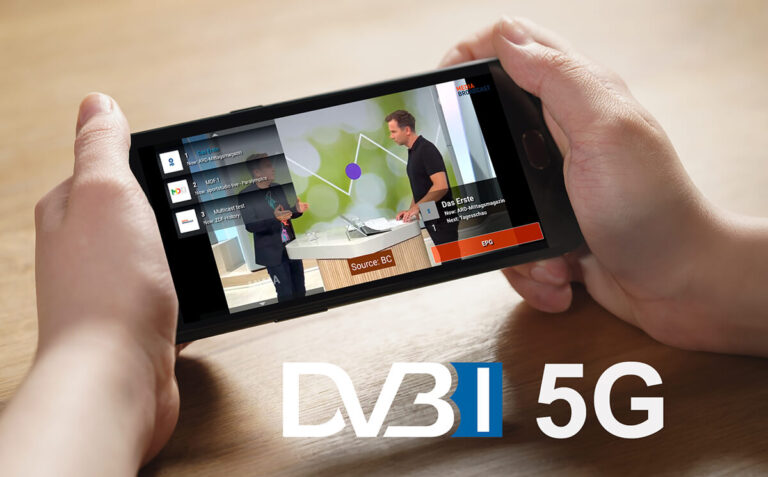
Table of contents
These are common questions we get from customers looking to launch or improve their Smart TV applications. We’ve worked with hundreds of services, apps and platforms over the years and run tests across more than 250 real devices in our lab. Whether you’re launching for the first time or scaling to new platforms, here’s what you should know about Smart TV app testing.
Getting Started with Smart TV App Testing
How to test your apps on Smart TVs?
The best way is to test your app on real TVs. Emulators and specs help, but they don’t tell you how your app behaves in the living room, with a remote control, under real-world conditions. We usually recommend testing on the actual devices your users are likely to have — meaning the platforms and models most common in your target market. That could include Samsung Tizen, LG webOS android TV, or HbbTV, but the key is focusing on the right mix based on where and how your app will be used.
A proper test setup includes functional testing, UI/UX checks, remote control usability, performance under load and more. If you’re not sure where to start, we can take care of the whole process and report what matters.
What is Smart TV app testing?
Smart TV app testing is the process of making sure your app works reliably across different TV models, platforms and environments. That means checking how it performs, looks, responds and integrates — from the TV’s hardware to the network backend.
It includes things like:
- Does the app crash or freeze?
- Are the fonts and buttons readable from 3 meters away?
- Does video playback stutter under load?
- Are ads, analytics or login flows working properly?
It’s not just about fixing bugs — it’s about delivering a good viewing experience across every platform you support.
Why is Smart TV application testing necessary before launch?
Because TVs don’t behave like phones or browsers — and because every platform has its own quirks. The biggest risk we see? Apps going live without proper testing and then failing on one major brand. That leads to complaints, bad ratings or even lost users and subscribers.
Testing helps catch those issues before your app reaches customers. You get more control, smoother launches and less firefighting after release.
What’s the easiest way to get started with Smart TV app testing?
Start small but smart. Many of our customers begin with a 50-hour testing package — a fixed scope, fast turnaround and expert feedback. We can usually kick things off in just a few days.
You don’t need to have everything figured out. We help define what to test, which devices to include and how to get the most value from the results. No complicated onboarding — just clear steps, useful findings and real confidence before launch.
Is Smart TV app testing only for large companies?
Not at all. Some of our best testing collaborations have been with small product teams or startups who want to get things right early. Testing doesn’t have to be expensive or overwhelming — especially if you focus on the key platforms and critical user flows.
Whether you have one app or five, we adjust to your scale and budget. What matters is delivering a reliable, usable experience across TVs — no matter the team size behind it.
Who needs Smart TV testing services?
Pretty much anyone involved in building or running a Smart TV service:
- OTT providers and video platforms
- Broadcasters and operators
- App developers or design teams
- Middleware and device manufacturers
If your service runs on a Smart TV, testing helps make sure it works — and keeps working.
Devices, Platforms and Coverage
What devices should be included in Smart TV app testing?
Focus on the devices your actual users have. It’s tempting to just test on the newest models, but real usage often includes older TVs, cheaper models, or brand-specific quirks. We help you pick the right mix based on your target markets and usage data.
For example, a streaming app launching in Northern Europe might prioritize Samsung Tizen (2018–2023), LG webOS and Android TV-based models from big brands. For broadcasters elsewhere, HbbTV compliance may be critical. We maintain a testing zoo of over 250 devices covering all major brands, platform versions and screen sizes — so we’ve likely already got what you need.
How many devices are needed to ensure reliable Smart TV app test coverage?
There’s no one-size-fits-all number, but we often recommend starting with 10–15 key devices that cover the biggest user base and edge cases. That usually includes a few new models, some older ones still in use and different operating systems.
As the app matures or expands to new markets, we can expand the test set. The key is testing across generations and hardware variations — not just screen size, but chipsets, memory setups, remote styles and OS differences.
How do we ensure our app works across multiple TV generations?
That’s where lab testing really makes a difference. In our setup, we test on both new and older models — including TVs from as far back as 2012. These older devices often have slower processors, outdated browsers, or twists that don’t show up on newer sets.
We look for performance issues, code compatibility, rendering problems and long-term compatibility risks. And we simulate real usage too — not just “does it load,” but how it feels to navigate, stream and interact.
Can we test Smart TV apps remotely or do we need to send hardware?
You don’t need to send anything — we probably already have the devices you need. But if there’s a specific model you want to include, you can of course send it to us. Our lab can also offer remote test access for real-time debugging or demo sessions.
It’s a fast and flexible way to test your app across platforms — without setting up a huge lab of your own.
What makes Sofia Digital’s Smart TV test lab unique?
Our test lab has over 250 Smart TVs, set-top boxes and HbbTV receivers — ranging from the latest models to early-generation devices. We’ve built this collection over years, specifically for Smart TV testing. It’s not just big, it’s *purpose-built*.
We support automated testing, performance benchmarks, real-time signal manipulation and remote device access. Most importantly, we’ve seen it all — weird bugs, hidden crashes, broken video, misbehaving remotes. That experience helps us test smarter and faster.
Testing Types and Common Issues
What types of testing are needed for Smart TV applications?
Smart TV testing isn’t just one thing — it’s a combination of different testing types, each checking for different risks:
- Functional testing: to make sure everything works as expected
- UI and UX testing: to ensure the interface is readable, usable and logical
- Performance testing: to see how the app behaves and handles resources during video playback, navigation, or other scenarios
- Player testing: different content formats, ad playback, smooth transitions between main content and supplemental content, accessibility features, subtitle rendering and so on
- Conformance testing: to check platform or regional standards are met
- Stress testing: to simulate heavy load or poor conditions
Depending on your app, you might also need backend, integration, or accessibility testing. We help you choose what’s relevant and skip what’s not.
What are the most common issues found in Smart TV app testing?
Some problems pop up over and over again:
- UI elements not aligned or cut off on certain screen resolutions
- Focus jumping unpredictably with remote navigation
- Long load times or stuttering playback
- Crashes when launching content or switching views
- Ads not displaying or analytics not firing
- Problems only visible on older models
We know where to look because we’ve seen these things hundreds of times. Our testing aims to catch them before your users do.
How is HbbTV app testing different from regular Smart TV app testing?
HbbTV apps are tightly linked to broadcast signals — so we also test signaling accuracy, app event triggering and HbbTV API integration. It’s more regulated from the top, especially in markets like Finland or Spain.
We use signal generators and HbbTV test suites in-house to validate app behavior across real broadcast conditions. This goes beyond functional UI tests — it’s about testing the whole hybrid experience.
What is conformance testing for Smart TV apps and why does it matter?
Conformance testing checks whether your app follows the rules of the platform or broadcaster. That includes UI behavior, feature support, analytics, video playback specs, DRM and even how ads run.
It’s essential if you want to pass local platform reviews or be allow-listed. For example, in HbbTV ecosystems, your app may need to meet a national broadcaster’s requirements before it’s available on Smart TVs.
We help collect, document and test against those requirements — and make sure your app stays compliant even after updates.
User Experience and UI Testing
How is Smart TV UI and UX testing done?
UI and UX testing on Smart TVs is mostly manual. That’s because we’re not just checking if something works — we’re evaluating how it *feels* to use. Is the layout logical? Are the menus readable from the couch? Can you easily find the settings with a remote?
We test:
- Layout and contrast for big-screen readability
- Navigation logic and focus order
- Menu and overlay behavior
- Interaction speed and responsiveness
- Whether essential features are easy to find and use
We often use test groups or accessibility reviews to spot issues you won’t find in automated runs. If something’s confusing or frustrating, we’ll flag it and suggest improvements.
What are common usability problems in Smart TV apps?
We regularly catch issues like:
- Text that’s too small or hard to read
- Confusing menu structures
- Features that only work with pointer remotes
- Focus jumping unpredictably
- Too many clicks to reach content
These things might seem small, but they’re the difference between an app that gets used and one that gets uninstalled.
How is remote control usability tested for Smart TVs?
Smart TVs don’t use touchscreens. Navigation is driven by arrow keys, OK, back and sometimes voice or pointer remotes. We test all of that.
Remote testing covers:
- Logical focus order
- Skipping or trapping issues
- Reaction time and double-click problems
- Handling of long presses, back, exit and colored buttons
We test with the actual remotes — not just keyboard emulators — to make sure interaction feels natural.
Do we need to meet accessibility requirements for Smart TV apps?
It depends on your market, but accessibility is becoming a bigger priority everywhere. For example, the EU accessibility directive applies to many public-facing services.
We can help check:
- Screen reader support
- Sufficient contrast and font size
- Logical navigation order
- Remote-control operability without vision
- Access to accessibility settings
- Rendering of supplemental subtitles and audio
You don’t always need full certification, but even small adjustments can make a big difference for users who need them.
Performance, Backend and Stress Testing
How are Smart TV apps stress tested under load?
We simulate what happens when your app is under real pressure — like during a major live event or content launch. This includes high concurrency (lots of users at once), repeated opening and closing, or navigating quickly between views.
We can also stress test your backend by generating load: simulating thousands of API calls per second, or stream requests and measuring how your app holds up. The idea is to find weak points before your users do.
What backend issues can be detected through Smart TV app testing?
Surprisingly often, issues that look like application bugs come from the backend:
- Missing metadata causing app crashes
- Metadata delays causing blank menus
- Metadata mistakes cutting playback short and rendering content unavailable
- Failures in advertising services
- Playback problems from DRM mismatches
- Region-lock issues or faulty fallback logic
We monitor how the app behaves when backend elements respond slowly, fail, or send unexpected data. This helps catch real-world errors you won’t see in isolated unit tests.
How can Smart TV testing reveal memory or playback problems?
Some TVs — especially older models — don’t have much memory. That can cause crashes, freezing, or degraded playback performance if your app is too heavy or leaks memory over time.
We test how your app handles:
- Long sessions with multiple video plays
- Switching between content or views
- Long pauses in content playback
- Cached assets and memory clean-up
If we find playback stuttering or out-of-memory crashes, we’ll show you exactly where it happens and why. It’s especially important for VOD or long-form streaming apps.
How to test Smart TV apps in poor network conditions or during buffering scenarios?
Not everyone has perfect Wi-Fi. We simulate slow, dropped or unstable connections and watch how your app reacts. Do error messages appear properly? Does the player retry or give up? Are there endless spinners?
This kind of resilience testing is key for maintaining user trust — especially on shared networks or in regions with spotty coverage.
How to test app behavior in different geographical locations?
In addition to simulating different network conditions, our VPN setup also enables us to test any device on any geolocation needed. This can be useful either to verify that the application and content delivery works as expected or on the other hand to make sure that the content is only available where it should be (i.e. making sure any geoblocks work as expected).
How to test graceful degradation on limited-capability TVs?
Some TVs simply can’t do everything — especially older or budget models. We check how your app behaves when something isn’t supported: animations, certain formats, even basic APIs.
A well-built app will fall back cleanly or disable features that don’t work, without crashing or blocking use. We’ll flag anything that breaks or creates a dead-end experience.
Analytics and Monitoring
How to verify analytics implementation in Smart TV apps?
We check that all expected analytics events are triggered — and triggered correctly. That includes page views, content starts, ad events, error logs and custom events like playback stops or logins.
We validate what gets sent, when and in what format. This can catch problems like:
- Events not firing at all
- Duplicates or misfired events
- Incorrect parameters (wrong video ID, user ID, etc.)
We can work with your own analytics platform (e.g. Google Analytics, Conviva, Youbora) or provide raw network logs and event traces for you to analyze. We can also offer our own small-scale analytics platform to get device share data from the target markets, this will be helpful in setting up the correct scope for the test plans.
How to test crash reporting functionality in Smart TV environments?
Crash reporting tools are critical — especially for production environments. We validate that:
- Crashes get reported (not just swallowed)
- Reports include enough context to debug the issue
- Silent failures like infinite spinners are logged properly
Depending on your SDK, we can simulate failures (e.g. network drops, memory leaks, broken streams) and confirm that your logging tools catch and report them.
Good reporting shortens your debug cycles. We help make sure it’s working before the real users hit any issues.
Testing Methods, Automation and Tools
How does manual testing compare to automated Smart TV testing?
Manual testing is great for usability, layout and real-world interaction — especially with remotes. Automated testing shines when checking repetitive flows, regression cases and basic functionality across many devices.
We often combine both. Manual testing catches design or UX issues, while automation helps scale up and repeat essential checks. It’s not either/or — it’s about balance.
What is black box vs white box testing in Smart TV development?
Black box testing: We test how the app behaves from the outside — without knowing what’s going on inside the code. This includes integration testing and checking if the UI behaves as expected.
White box testing: We go deeper, testing internal logic, module-level functions, or custom APIs. This often requires coordination with your dev team.
We use both types depending on your needs and how much internal access can be arranged.
What tools are used in automated Smart TV testing projects?
We mainly use Suitest for automated testing on real TVs — it supports most platforms like Tizen, webOS and Android TV. We also build custom scripts using Mocha.js, Cypress, Jenkins and GitLab, pipelines and our internal automation libraries.
Tests can run continuously and deliver detailed logs, screenshots and error reports. We can help you set up something similar or just run everything from our side.
Can Smart TV test automation be integrated with our CI pipeline?
Yes — and we often recommend it. We can plug into your existing pipeline (like Jenkins or GitLab) and trigger tests when new versions are deployed. You’ll get automated test results as part of your release cycle.
This is ideal for teams doing continuous deployment or working on larger-scale apps where frequent updates are expected.
Certification and Market Readiness
What is Smart TV device certification and is it mandatory?
Certification requirements vary by region and platform. In the Nordics, for example, devices and apps may need to comply with local standards like Cable Ready HD or Antenna Ready logos. HbbTV platforms also have strict broadcaster-level conformance expectations.
It’s not always legally required, but certification can:
- Speed up platform approvals
- Increase user trust
- Reduce support issues after launch
We’ve helped customers through national certifications in Finland, Norway, Sweden (through our partnership with Labatus) Malaysia and other markets. If certification is relevant for your app or device, we’ll guide the process.
How to prepare your app for launch in new markets like the Nordics or Asia?
Each region has its own ecosystem. To prepare for launch, we help with:
- Understanding platform requirements (e.g. local broadcast behavior, subtitle rules, ad specs)
- Running regional conformance tests
- Ensuring the UI fits language, accessibility and content expectations
We’ve supported deployments in Finland, Spain, Singapore and more. Local market experience makes the testing smoother and avoids nasty surprises.
How does certification differ between HbbTV and Smart TV platforms?
HbbTV certification focuses heavily on broadcast signal integration and API compliance. Testing includes verifying signaling, video playback, remote behavior and accessibility features.
Smart TV platforms (like Tizen or webOS) often require passing manufacturer-specific QA. These tests check UI, navigation, performance and integration with platform services (ads, payments, etc.).
We test for both types and help ensure your app meets the exact criteria.
What compliance standards (GDPR, accessibility, etc.) apply to Smart TV apps?
Smart TV apps may be subject to:
- GDPR or similar privacy laws (depending on user data handling)
- Accessibility directives like the EU Web Accessibility Directive
- Platform-specific rules (e.g. Samsung or LG requirements)
We help test for common compliance gaps — things like missing consent flows, poor contrast ratios, inaccessible navigation, or incomplete metadata.
How to test Smart TV apps for regional compliance and privacy?
We simulate the real environments your app will run in. This includes language and locale settings, content restrictions and backend rules.
For privacy, we test:
- Consent dialog flows
- Data sharing behavior (e.g. with analytics or ads)
- Visibility of privacy notices or settings
Testing these early helps avoid launch delays and rebuilds later.
Updates and Maintenance
How to test app updates on Smart TVs?
App updates should always be tested like new releases — especially if they include changes to navigation, video playback, or platform integration. Even small updates can cause unexpected issues on specific platforms.
We usually test:
- Update installation behavior (silent, forced, optional)
- Changes to functionality or layout
- Regressions in performance or compatibility
We also verify that old, cached data doesn’t interfere with the new version and can check the CDN and origin server configurations to make sure stale content problems don’t happen – and that the cache-directives are understood also by older browsers.
Why regression testing is required after platform updates?
When Smart TV platforms update (especially Tizen or webOS), they can introduce new quirks — or break previously working features. We recommend re-running critical test cases on updated firmware and OS versions.
Our test lab helps here — we maintain devices across firmware versions and can compare results. This helps avoid getting caught off guard by a platform-side change.
How to establish an efficient testing cycle for regular app updates?
You don’t need to run a full test suite every time. Instead, we help define a regression test set — a focused group of tests that cover your core flows and known risk areas.
This allows faster turnarounds and keeps costs down while still dealing with critical issues. We can schedule recurring testing (e.g. monthly or per release) and provide fast feedback so your team can move confidently.
Timing and Budget
How long does a typical Smart TV testing process take?
It depends on the scope, but we can usually start in just a few days. A focused 50-hour test package might take one to two weeks including planning, execution and reporting.
If the app is larger or includes multiple platforms, we scale accordingly. But even complex projects don’t have to be slow — our experience means we already know what to look for and how to test efficiently.
Testing doesn’t need to delay your launch — in fact, it often speeds things up by catching issues early.
How much does Smart TV app testing cost and what do you get for it?
We offer flexible packages. Many clients start with a 50-hour or 100-hour block, which includes test planning, execution on real devices, reporting and follow-up.
You’ll get:
- A clear list of devices covered
- Issue reports with screenshots and reproduction steps
- Suggestions for fixes or improvements
- Optional retesting after updates
We also offer flat-rate or recurring testing options for larger teams. Everything is scoped transparently — no surprise bills.
Is it possible to test Smart TV apps with a limited budget or short deadline?
Absolutely. We often work with teams who have tight launch schedules or need a quick sanity check. Even 20–30 hours of targeted testing can uncover serious issues.
We help prioritize the most important devices and scenarios and can often start within a few days. It’s a smart way to catch issues without overloading your timeline or budget.
Let us help
Why do customers choose Sofia Digital for Smart TV app testing?
Three main reasons: device coverage, experience and flexibility.
We maintain one of the most comprehensive Smart TV test labs in the world — over 250 devices, across all major platforms and multiple generations. That means we can test your app on the same TVs your users have, not just a generic subset.
Second, we’ve seen almost everything. From HbbTV broadcast use cases to OTT video apps, regional compliance projects to full test automation — we’ve done it. That experience means faster onboarding, sharper test focus and better reporting.
And finally, we work the way our customers need. Some just want a quick 50-hour package. Others need help with platform certification, UX testing or automation setup. We adapt to your goals — with no fluff, no salesy process, just real expertise. We strive to build lasting and trusted relationships, supporting your business case and roadmap from start to finish.
Contact us to get your Smart TV application tested across 200+ real devices — including legacy and latest-generation models.
We’re ready to help you:
- Start quickly with a fixed-hour test package
- Get real-world feedback from actual devices
- Improve stability, UX and launch confidence
No need for a complicated setup. Just let us know your target markets and platforms — and we’ll take care of the rest. Read more about our Smart TV app testing services »
